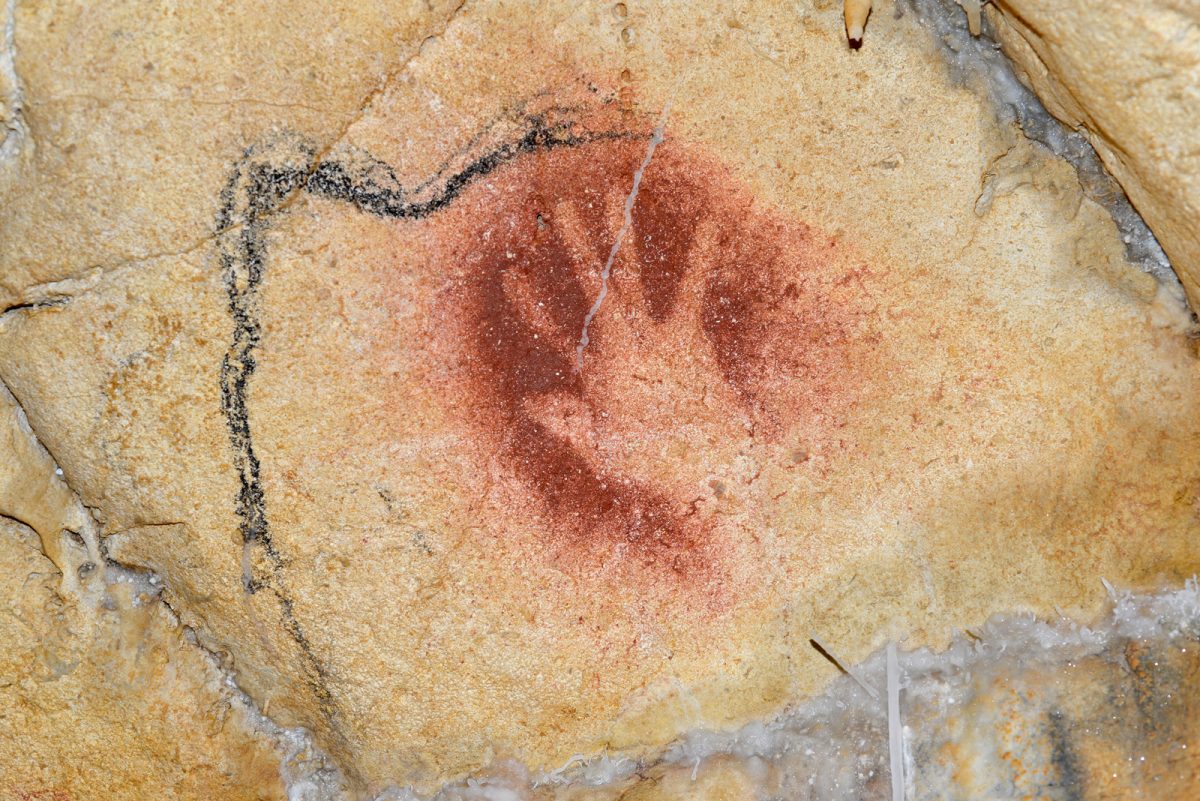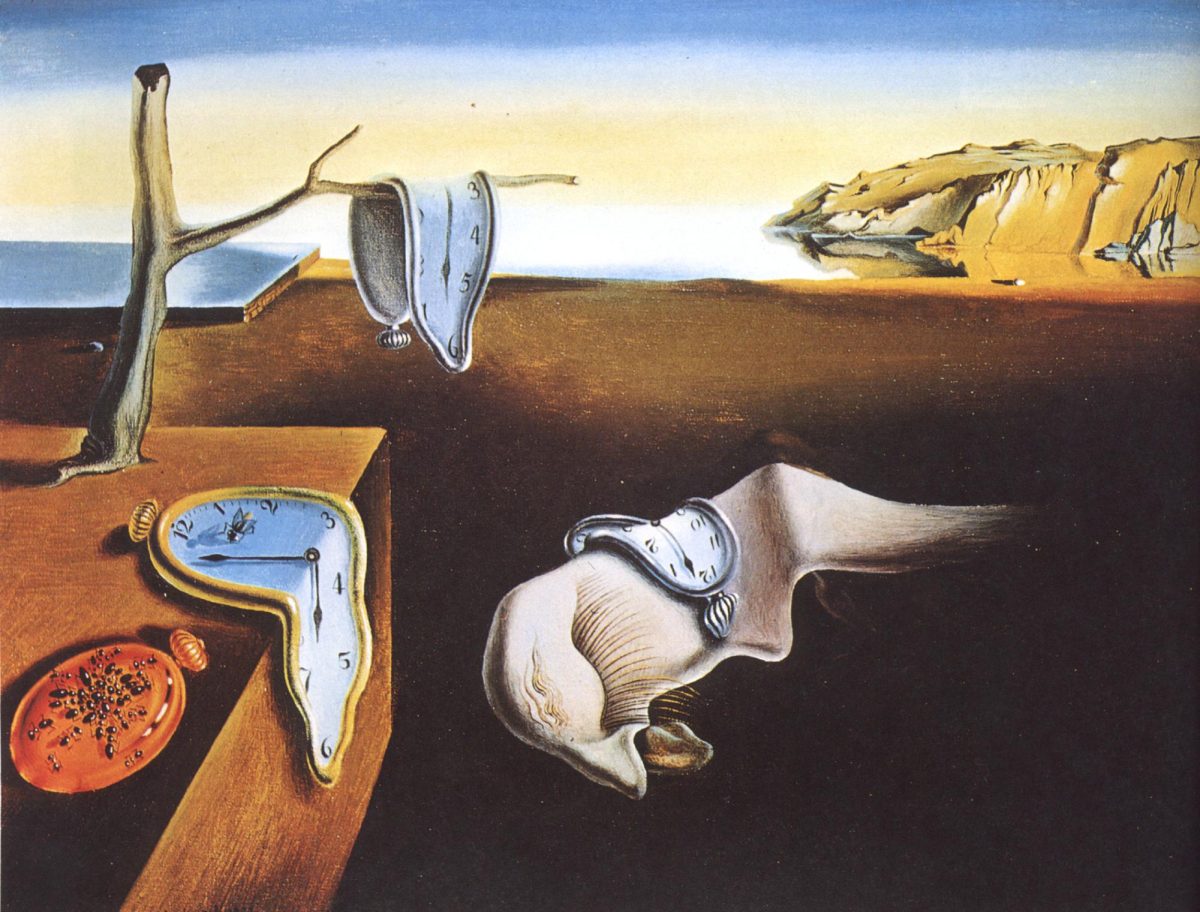The Persistence of Memory is not only one of Salvador Dali’s most famous works but one of the surrealist movement‘s most recognizable works as well. The inspiration for the painting came to Dali one day as he was eating Camembert cheese under the summer sun. As he sliced into it he found that it had become soft and runny, and he was struck with the inspiration for melting pocket watches. The surrealist movement strived to depict the imagery that the unconscious mind produces, showing dream-like and fantastic things to blend dreams and reality into an absolute reality or a super-reality. Surrealism itself is just the prefix ‘sur’ which means super, and realism, which is depicting something accurate to life. During this summer he noted that time had no relevance to him, he spent his days painting, eating, and spending time with his wife, Gala. The watches are representative of the irrelevance that he felt time had. The soft melting creature figure on the ground is a self-representation by Dali, depicting himself as this formless, vague beast. Its eye is closed, showing that the creature is asleep, perhaps it is dreaming. In the background, the rocky outcroppings of Cape Creus can be seen as Dali depicted his homeland of Catalonia in much of his artworks.
Dali developed a method for creating his artworks, the paranoiac-critical method, especially the ones which contained optical illusions. This method involves invoking a paranoid state where supposedly one’s psychological identity is deconstructed and allows for them to be completely subjective in whatever they are trying to portray. In this state, one’s mind is supposed to link things that should not rationally be linked, creating novel and surreal imagery. Dali himself described it as a “spontaneous method of irrational knowledge based on the critical and systematic objectivity of the associations and interpretations of delirious phenomena.”
The closed pocket watch on the bottom left is shown to be covered in ants, a recurring image that can be found in many of Dali’s works. The ants represent death and decay. This was inspired by him seeing them devour the remains of small animals when he was a boy. In his autobiography The Secret Life of Salvador Dali, he mentions a moment from his childhood which might have sparked this symbolism that ants held. “[..]The next morning a frightful spectacle awaited me. When I reached the back of the wash-house, I found the glass over-turned, the ladybugs gone and the bat, though still half-alive, bristling with frenzied ants, its tortured little face exposing tiny teeth like an old woman’s[…]”. Death is not the only thing that the ants can be symbolic of. In one of his works, the ants take on a double meaning to represent his desires, while also representing the fear and putrefaction he feels because of said desires. Dali was said to have an irrational fear of women, and in that work the ants represent the longing he felt for a woman, yet the inexplicable horror that followed that longing. The meaning of these insects is a blend of both attraction and repulsion.
In The Persistence of Memory, the ants represent death. They sit atop the only closed pocket watch, perhaps the watch itself being closed could be interpreted as death and its inevitability as well. Since the inspiration was the supposed unimportance of time to Dali during those summer months, the closed watch could be seen as the final nail in the coffin, death itself, while the ants are the slow encroaching menace that death is. In the dreamlike state invoked in this painting time has no meaning, it has no meaning to the ants, it has no meaning to the clocks, it has no meaning to the soft Dali-creature which lays asleep on the ground. For the creature itself is asleep, it is lost in the unconscious mind, so time has no meaning or importance to it.
Another creature not mentioned until now that is present in the painting is the fly, casting a human shadow as it sits atop the melting watch above the closed one. The fly is another recurring symbol in Dali’s work. In many traditional works they mean death the same as the ant, but the fly holds much more meaning than that to Dali. The fly in some of his works is representative of Catalan identity, and the fact that the fly casts a human shadow on the watch is representative of this in my opinion. During the time that Dali painted this he had been experimenting with different ways to invoke hallucinations and paranoid imagery in himself, this involves channeling the personal identity, allowing him to create directly from his unconscious mind. This fly casting a shadow on the clock representative of time’s irrelevance could be showing how he channels his pure inner identity to create these artworks, the true identity, not the one which is presented to others.
Thank you for reading my review and analysis over this painting! I am not an art critic by any means, but I enjoy sharing information and my opinions on things I find interesting. I hope that by posting this one of you might find a new interest in Dali’s work or the surrealist movement as a whole. As always, have an amazing day readers and go Pirates!

















